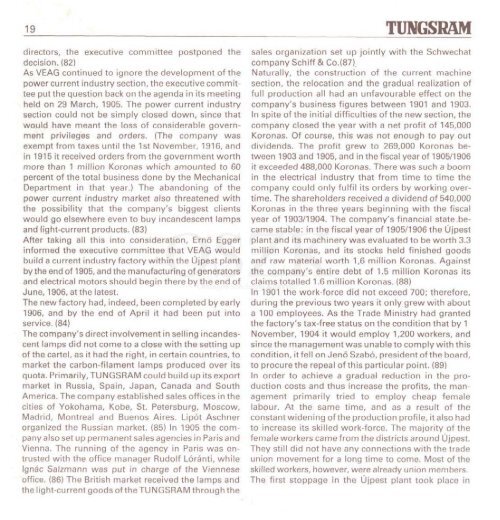THE HISTORY OF TUNGSRAM 1896-1945 - MEK
THE HISTORY OF TUNGSRAM 1896-1945 - MEK
THE HISTORY OF TUNGSRAM 1896-1945 - MEK
- No tags were found...
Create successful ePaper yourself
Turn your PDF publications into a flip-book with our unique Google optimized e-Paper software.
19 <strong>TUNGSRAM</strong>directors, the executive committee postponed thedecision. (82)As VEAG continued to ignore the development of thepower current industry section, the executive committeeput the question bacl< on the agenda in its meetingheld on 29 March, 1905. The power current industrysection could not be simply closed down, since thatwould have meant the loss of considerable governmentprivileges and orders. (The company wasexempt from taxes until the 1st November, 1916, andin 1915 it received orders from the government worthmore than 1 million Koronas which amounted to 60percent of the total business done by the MechanicalDepartment in that year.) The abandoning of thepower current industry market also threatened withthe possibility that the company's biggest clientswould go elsewhere even to buy incandescent lampsand light-current products. (83)After taking all this into consideration, Erno Eggerinformed the executive committee that VEAG wouldbuild a current industry factory within the Ujpest plantby the end of 1905, and the manufacturing of generatorsand electrical motors should begin there by the end ofJune, 1906, at the latest.The new factory had, indeed, been completed by early1906, and by the end of April it had been put intoservice. (84)The company's direct involvement in selling incandescentlamps did not come to a close with the setting upof the cartel, as it had the right, in certain countries, tomarket the carbon-filament lamps produced over itsquota. Primarily, <strong>TUNGSRAM</strong> could build up its exportmarket in Russia, Spain, Japan, Canada and SouthAmerica. The company established sales offices in thecities of Yokohama, Kobe, St. Petersburg, Moscow,Madrid, Montreal and Buenos Aires. Lipot Aschnerorganized the Russian market. (85) In 1905 the companyalso set up permanent sales agencies in Paris andVienna. The running of the agency in Paris was entrustedwith the office manager Rudolf Loranti, whileIgnac Salzmann was put in charge of the Vienneseoffice. (86) The British market received the lamps andthe light-current goods of the<strong>TUNGSRAM</strong> through thesales organization set up jointly with the Schwechatcompany Schiff & Co.(87)^Naturally, the construction of the current machinesection, the relocation and the gradual realization offull production all had an unfavourable effect on thecompany's business figures between 1901 and 1903.In spite of the initial difficulties of the new section, thecompany closed the year with a net profit of 145,000Koronas. Of course, this was not enough to pay outdividends. The profit grew to 269,000 Koronas between1903 and 1905, and in the fiscal year of 1905/1906it exceeded 488,000 Koronas. There was such a boomin the electrical industry that from time to time thecompany could only fulfil its orders by working overtime.The shareholders received a dividend of 540,000Koronas in the three years beginning with the fiscalyear of 1903/1904. The company's financial state becamestable: in the fiscal year of 1905/1906 the Ojpestplant and its machinery was evaluated to be worth 3.3million Koronas, and its stocks held finished goodsand raw material worth 1,6 million Koronas. Againstthe company's entire debt of 1.5 million Koronas itsclaims totalled 1.6 million Koronas. (88)In 1901 the work-force did not exceed 700; therefore,during the previous two years it only grew with abouta 100 employees. As the Trade Ministry had grantedthe factory's tax-free status on the condition that by 1November, 1904 it would employ 1,200 workers, andsince the management was unable to comply with thiscondition, it fell on Jeno Szabo, president of the board,to procure the repeal of this particular point. (89)In order to achieve a gradual reduction in the productioncosts and thus increase the profits, the managementprimarily tried to employ cheap femalelabour. At the same time, and as a result of theconstant widening of the production profile, it also hadto increase its skilled work-force. The majority of thefemale workers came from the districts around Ojpest.They still did not have any connections with the tradeunion movement for a long time to come. Most of theskilled workers, however, were already union members.The first stoppage in the Ujpest plant took place in








![Letöltés egy fájlban [4.3 MB - PDF]](https://img.yumpu.com/50159926/1/180x260/letaltacs-egy-fajlban-43-mb-pdf.jpg?quality=85)







